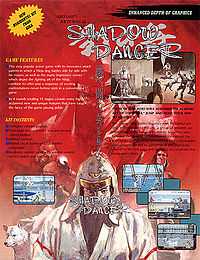Shadow Dancer
| Shadow Dancer | |
|---|---|
 Shadow Dancer arcade flyer | |
| Developer(s) | Sega |
| Publisher(s) | Sega |
| Director(s) | Motoshige Hokoyama[1] |
| Series | Shinobi |
| Platform(s) | Arcade, Amiga, Atari ST, Amstrad CPC, Commodore 64, Sega Master System, ZX Spectrum |
| Release date(s) | November, 1989 |
| Genre(s) | Platform Hack and slash |
| Mode(s) | Single-player or two-player (alternating turns) |
| Cabinet | Upright |
| Arcade system | Sega System 18 |
Shadow Dancer (シャドー・ダンサー)[2] is a side-scrolling action game produced by Sega originally released as an arcade game in 1989. It is the second arcade game in the Shinobi series, following the original Shinobi itself. The game was developed on the Sega System 18 motherboard hardware. Home versions were released for the Master System and various home computers. A loose adaptation was also developed for the Mega Drive/Genesis titled Shadow Dancer: The Secret of Shinobi.
Plot
A terrorist group is planting numerous time bombs throughout the city. The player, a ninja master accompanied by a canine partner, sets out on four missions to dismantle the bombs and destroy the criminal syndicate behind these acts.
Gameplay
The play mechanics of Shadow Dancer are not much different from the arcade version of the original Shinobi. The controls and almost all of the player's moves from the original Shinobi are present here as well. The biggest change is the addition of a canine companion that follows the protagonist around. When the dog barks towards an enemy, the player can sic the dog on the enemy by pressing the attack button while crouching, allowing the player an opportunity to attack the enemy while it's being bitten by the dog. However, if the player takes too long to attack the bitten enemy or the enemy has a strong defense, then the dog will be hurt and will turn into a harmless pup. The dog will remain in pup form until the player acquires the next time bomb or finishes the stage. The dog does not appear during boss battles.
The player's weapons consists of an unlimited supply of shurikens and a sword which is used when adjacent to an enemy. When the player collects half of the time bombs in each stage, stronger weapons will be granted until the player finishes the stage or loses a life. The player can also use from one of three random ninjutsu techniques (called "Ninja Magic" in the game) that will clear the entire screen of enemies. Normally, these techniques can only be used once per stage, but if the player continues the game by inserting more coins and pressing START, the protagonist will restart the stage with two units instead of one. Bonus points will be awarded if the player completes the game without using shurikens or ninjutsu.
There are four different missions, consisting of three stages for the first mission and four stages each for the remaining three. In the first few stages of each mission, the player must collect a certain amount of time bombs scattered throughout the stage in order to proceed to the goal. The final stage in each mission is a confrontation between him and the boss. Between missions, the player will participate in a bonus stage where (from the character's perspective) an army of ninjas dropping down from a building must be shot down. The player will be awarded extra lives if he successfully completes these bonus stages.
Home versions
Master System
The Master System port of Shadow Dancer was released 1991 exclusively in Europe and Brazil. Although this version bears the title Shadow Dancer: The Secret of Shinobi on the packaging (much like the Genesis version released during the same year), it is actually based on the arcade version and is simply titled Shadow Dancer in-game. However, most of the content from the arcade version was cut and the play mechanics were modified a bit. Missions now consists of a single side-scrolling stage and a boss encounter. The player's canine companion no longer follows him around, but can still be summoned to kill certain enemies from a distance. Collecting time bombs is now an optional task that the player can conduct while on his way to the goal. When the player gathers all five time bombs in each mission, he will gain an attack power-up for the next boss battle. The attract sequence now shows profiles for the protagonist (who is named Fuma in this version) and most of the enemy characters.
Home computers
Shadow Dancer was released on various home computer formats in Europe during 1991. Versions released for the Commodore Amiga, Atari ST, Commodore 64, Amstrad CPC, and ZX Spectrum. These versions were published by U.S. Gold and developed by Images.
Reception
| Reception | ||||||||
|---|---|---|---|---|---|---|---|---|
| ||||||||
The game was reviewed in 1991 in Dragon #172 by Hartley, Patricia, and Kirk Lesser in "The Role of Computers" column. The reviewers gave the game 5 out of 5 stars.[5]
References
- ↑ Okunari, Yosuke. Legend of Joe Musashi: SHINOBI Music Collection (booklet). Japan: Wave Master. p. 8. WM-0626~9.
- ↑ Somewhat like Shinobi, Shadow Dancer has a kanji form of its name: 影の舞. This particular phrase is used extensively throughout the game.
- ↑ "Shadow Dancer Overview". Allgame. Retrieved 11 August 2013.
- ↑ "Shadow Dancer Review". GameSpot. Retrieved 11 August 2013.
- ↑ Lesser, Hartley; Lesser, Patricia & Lesser, Kirk (August 1991). "The Role of Computers". Dragon (172): 55–64.
External links
- Shadow Dancer at the Killer List of Videogames
- Shadow Dancer at MobyGames
- Shadow Dancer at World of Spectrum
- Shadow Dancer brochure at the The Arcade Flyers Archive
| ||||||||||||||||||||||||||